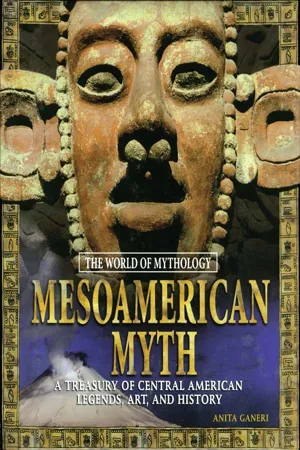
eBook - ePub
Mesoamerican Myth: A Treasury of Central American Legends, Art, and History
A Treasury of Central American Legends, Art, and History
This is a test
- 96 pages
- English
- ePUB (mobile friendly)
- Available on iOS & Android
eBook - ePub
Mesoamerican Myth: A Treasury of Central American Legends, Art, and History
A Treasury of Central American Legends, Art, and History
Book details
Book preview
Table of contents
Citations
About This Book
In order to understand the course of economic and social disintegration in the Soviet Union, various questions were put to Soviet officials and economic and other policy advisors of the 1980s. This text assembles the analyses of key issues and turning points into a history of the systemic collapse.
Frequently asked questions
At the moment all of our mobile-responsive ePub books are available to download via the app. Most of our PDFs are also available to download and we're working on making the final remaining ones downloadable now. Learn more here.
Both plans give you full access to the library and all of Perlego’s features. The only differences are the price and subscription period: With the annual plan you’ll save around 30% compared to 12 months on the monthly plan.
We are an online textbook subscription service, where you can get access to an entire online library for less than the price of a single book per month. With over 1 million books across 1000+ topics, we’ve got you covered! Learn more here.
Look out for the read-aloud symbol on your next book to see if you can listen to it. The read-aloud tool reads text aloud for you, highlighting the text as it is being read. You can pause it, speed it up and slow it down. Learn more here.
Yes, you can access Mesoamerican Myth: A Treasury of Central American Legends, Art, and History by Anita Ganeri in PDF and/or ePUB format, as well as other popular books in Politics & International Relations & Politics. We have over one million books available in our catalogue for you to explore.
Information
MAYA CREATION MYTHS
Like the Aztecs, the Maya told many stories about how the world came into being. They believed, as the Aztecs did, that creation happened because of the will of the gods. In a world view that had many similarities with that of the Aztecs, the Maya envisioned the Earth as vast and flat, with thirteen levels of heaven above and nine layers of underworld beneath. At each of the four corners of the Earth grew a tree that held up the sky. In some versions of the myths, giants took the place of the trees. In the center of the Earth stood a greater tree, which joined heaven, the Earth, and the underworld.
The following series of creation myths tells the story of how the gods formed the Earth and the animals, how they then created people at their third attempt, and how, finally, they created the Sun and the Moon.
THE CONVERSATION
OF THE GODS
Before time began, there only existed a great, still expanse of sea and sky. There were no animals, plants, or people. There were no rocks, plains, or forests. There was nothing that could make a noise, and nothing that could move. There was only the great sea god, Gucumatz (goo-koo-mahts), and the great sky god, Huracan (hoo-rah-kan). In the silence, an extraordinary conversation started up between the two of them, and from their conversation the Earth and everything on it was created.
In the sea, the god Gucumatz, the Plumed Serpent, shimmered and glittered in the water. He lay coiled beneath the waves, surrounded by glimmering blue and green quetzal feathers. At the same time, in the sky above, the god Huracan, known as the Heart of Heaven, appeared as a shining streak of lightning. In the darkness and stillness, the two gods began to talk to each other, debating and deliberating long into the night.
CREATING THE EARTH
During their conversation, Gucumatz and Huracan planned the creation of the Earth, the dawning of the first day, and the making of people and their food. They created a vision of what the Earth should look like, how plants and trees should grow in the soil, how the Sun and Moon should move in the sky, and how animals and people should live.
“Let it be done!” they said. “Let the emptiness be filled! Let the waters of the sea be pushed back to make space for the Earth to appear. Let there be light, let there be a dawn in the sky and on Earth. Then let human beings be formed!”
As the gods spoke, their words had a magical and immediate effect. The waters of the sea were pushed back, and the Earth rose up. Steepsided mountains appeared from the water and grew instantly. Forests covered the landscape, and plants sprouted in the fields. Water collected in hollows to make the great lakes, and flowed down the sides of the mountains in raging rivers and babbling streams.
Gucumatz and Huracan looked at their work and were overjoyed. But there was still one part of creation missing. The gods needed creatures who would thank and praise them for all their great work. So they decided to create the birds and animals of the land, hoping that they would honor the gods.
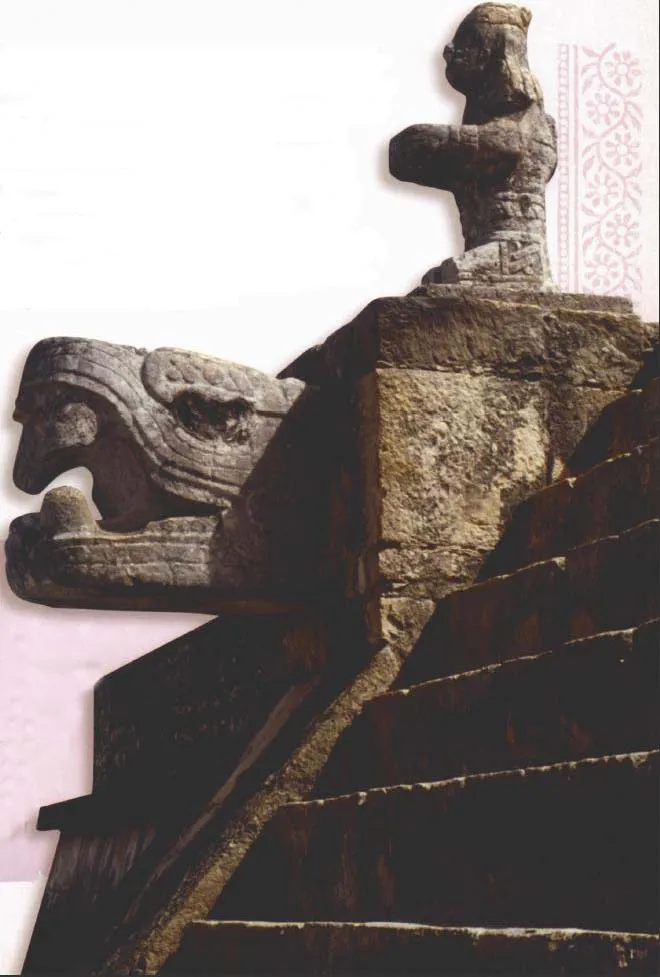
Right: A stone head of the Plumed Serpent, Gucumatz, stands at the top of a stairway leading to the Temple of the Warriors in the city of Chichen Itza, Mexico. Legend says that he emerged from the ocean to create the world, then disappeared back into the sea. In Aztec mythology, he became merged with the powerful god Quetzalcoatl.
CITY BUILDING
Maya civilization was based around numerous individual city-states, each with its own ruler and government. The Maya built their great cities both in the highland and lowland regions of Central America. Each city was carefully planned. At the heart of a city were great plazas, or squares. These were ceremonial areas, surrounded by important religious and government buildings. Such buildings included the large and highly decorated royal palaces, towering pyramid-temples, and ball courts. Groups of temples were linked by enormous stone causeways. Immediately outside the ceremonial center were smaller temples, shrines, and the houses of less important nobles. The ordinary people of the city made their homes outside these sacred areas.
City construction reached its peak during the so-called Maya Classic Period (c. 250–900 c.e.). Many of the major cities, including Tikal, flourished at that time. Later, Chichen Itza in the Yucatan Peninsula of present-day Mexico became the most powerful city The city’s location was chosen because three natural wells provided plentiful water all year round. The city may have flourished until the early thirteenth century, when revolt and civil war led to its decline. Today, Chichen Itza is a World Heritage Site and the most visited of the ancient Maya cities.
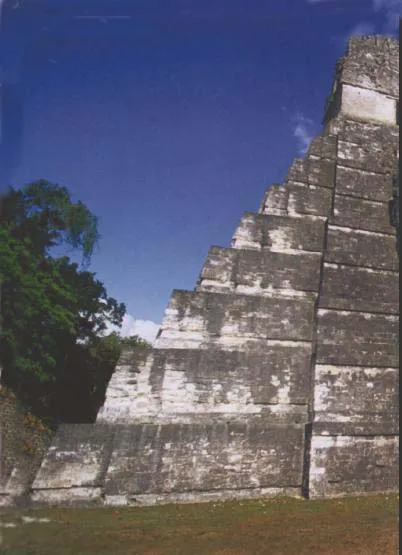
Right: This temple stands in the ceremonial center of Tikal in present-day Guatemala. Tikal is the largest of the ancient ruined Maya cities. It reached the height of its power during the Maya Classic Period, but declined and was abandoned in the tenth century.
CREATION OF ANIMALS
The gods set about their task eagerly. They created animals to live in the forests and mountains: deer, birds, pumas, jaguars, and snakes. They gave each of these animals a home to live in where they would be provided with food and shelter.
“Sleep in the fields and valleys by the riverbanks,” they told the deer. “And in the thickets and woods.”
“You shall live in the trees and among the vines,” they told the birds. “There you shall make your nests.” Then the gods spoke to the animals. “Hiss, cry, warble, and call as you will, according to your kind,” they said. “Speak our names, sing our praises, call on us, and worship us. For we have made you and given you a place to live.”
To the gods’ dismay, however, the animals were unable to speak. Some of them could squawk or screech, while others could howl, cry, or roar. But they could not speak words as the gods did. They could not even speak to each other, for each of them made a different sound. The gods were not pleased. If the animals could not speak properly, how could they worship the gods? They had planned for the animals to rule the world.
“Because you cannot speak to us, we have changed our minds,” the gods said. “You shall have your food, fields, homes, and nests but we shall make other beings who will honor us. You will become food for each other and for the people to come. This will be your destiny”
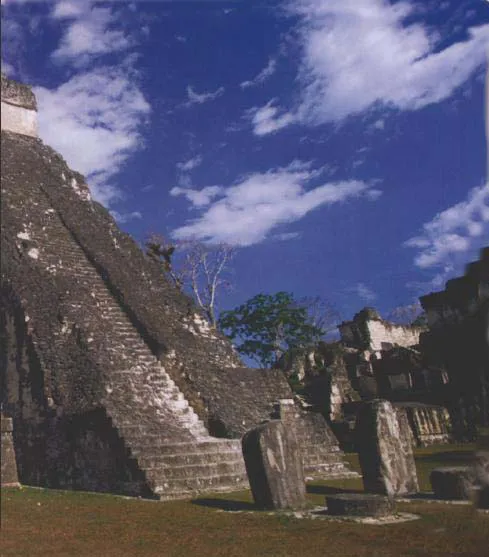
Maya Religion
Religion played a central part in Maya life. Like the Aztecs, the Maya worshipped a great many gods and goddesses who, they believed, created and controlled every aspect of the world. The Maya believed that the gods could be helpful or harmful and it was vital to please them in order to obtain their aid.
THE GODS
The Maya’s chief god was Itzamna (eet zam-nah), or “Lizard House.” He was also known as Hunab Ku (hoo-nahb koo), the creator of the universe. He was considered lord of the heavens. He was credited with teaching the Maya how to write and use their sacred calendar, and with bringing them knowledge of the knowledge of the maize plant. As bringer of writing, he was patron of priests and scribes. He is usually shown as an old man with toothless jaws, sunken cheeks, and a long nose.

Left: This carving shows the god Itzamna holding a snake called a “vision serpent.” The snake was associated with spiritual journeys. The Maya believed that people could travel along the snake’s body to reach the world of the spirits, or meet the gods hidden in the snake’s coils.

Right: The fa?ade of this Maya palace in Sayil, on the Yucatan Peninsula in Mexico, has the face of Chac, the rain god, in the center. In carvings and illustrations, he was shown with a long, spout-like nose for pouring rain onto the Earth. He also had T-shaped eyes, which represented rain falling from the sky.
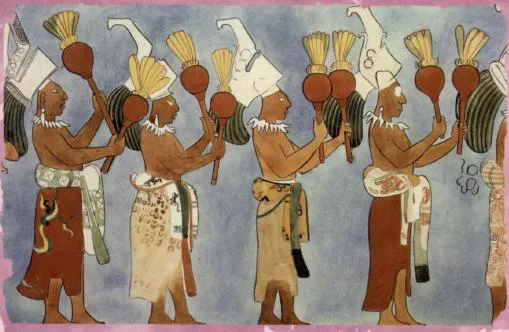
Left: This reconstruction of a Maya wall painting from Bonampak in Mexico shows a religious ceremony with richly dressed priests and musicians. Religious festivals in honor of the gods took place throughout the year. Priests conducted the festivals and made sacrifices. They also advised the city rulers about important matters.
Itzamna’s wife was called Ix Chel (eesh c...
Table of contents
- Cover
- Half Title
- Copyright Page
- Title Page
- Table of Contents
- Introduction
- Aztec Creation Myths
- Tales of the Aztec Gods
- Maya Creation Myths
- Glossary
- For More Information
- Index